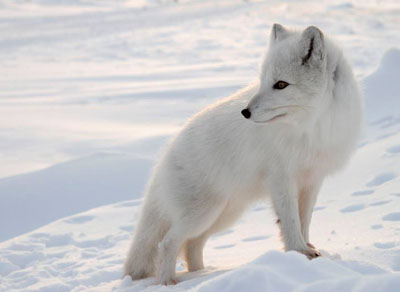Booming population is behind uptick in rabid fox encounters, says wildlife manager
Nunavut's government has reported six rabies cases in foxes since November.

A rise in reported run-ins with rabid foxes in Nunavut in recent months is related to a boom in fox populations, according to the Environment Department.
Jonathan Pynn is the Govnerment of Nunavut’s wildlife operations regional manager for South Baffin. He said that it’s normal for fox populations to rise and fall over the years, and with a rise in fox populations comes a risk for more rabies infections.
“We have noticed slight increases in some local populations — we’ve had an increased number of reported fox encounters here in Iqaluit this year,” Pynn said.
“With rabies being endemic to foxes, after an increase in the number of foxes, we can expect to see more foxes infected with rabies,” he said.
Population booms of foxes in Nunavut tend to be linked to availability of prey. Zoologist and researcher Dominique Fauteux told Nunatsiaq News in August that 2021 had been a good year for lemming populations. Lemmings are the Arctic’s most populous mammal, and the cyclical rise and fall of their populations has a major impact on their predators, including foxes.
Pynn said he expects the fox population will go down again — it’s “just how nature’s population cycles work.”
As of Jan. 7, the Nunavut government had reported confirmed rabies cases in six foxes — three in Iqaluit, two in Igloolik and one in Arctic Bay. Additional sightings of aggressive foxes have been reported in those communities and in Sanikiluaq.
Nunavut’s Health Department issued public health advisories for rabies in Iqaluit and Pangnirtung on Oct. 22 and Nov. 1.
In December, a woman from Igloolik was bitten by a rabid fox. She immediately sought medical treatment and has since recovered.
Since November, three domestic dogs have also tested positive for rabies after being bitten by foxes.
Pynn stressed the importance of reporting wildlife sightings not just on social media but directly to conservation officers so officials can act accordingly.
“Social media is a great tool for people to make the community aware of fox encounters, but we strongly encourage all public to report any wildlife sighting to their community conservation officer, so we can respond to the situation,” he said.
He also strongly advised people who have been bitten or who have pets who have been bitten to seek medical attention as soon as possible.
“We just like to remind people if they catch a fox, be safe. If you can, get your rabies vaccines,” Pynn stressed. “Just be safe when handling any wild animal, whether it’s alive or dead, and just work with us. We’re here to work with you.”
Signs of rabies in animals include behaving strangely, staggering, frothing at the mouth, choking or making strange noises. Animals exhibiting these signs should be avoided and reported to a regional environmental health officer.